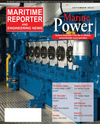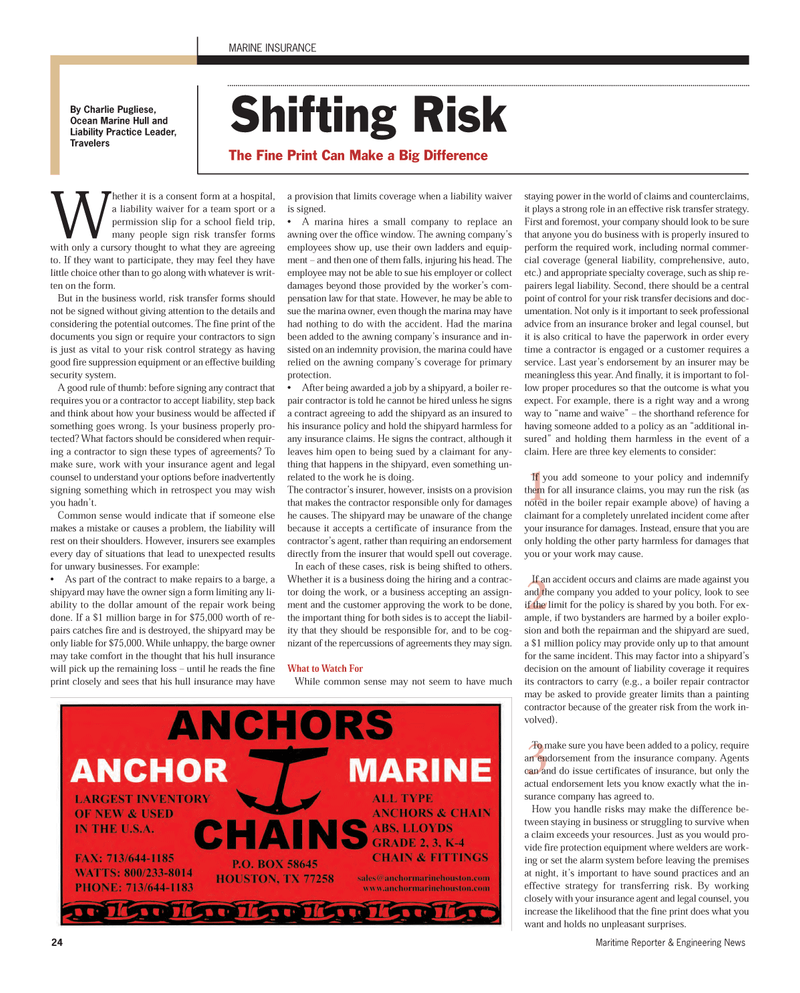
Page 24: of Maritime Reporter Magazine (September 2012)
Marine Propulsion Annual
Read this page in Pdf, Flash or Html5 edition of September 2012 Maritime Reporter Magazine
32124Maritime Reporter & Engineering News MARINE INSURANCEShifting RiskThe Fine Print Can Make a Big Difference Whether it is a consent form at a hospital,a liability waiver for a team sport or a permission slip for a school field trip, many people sign risk transfer forms with only a cursory thought to what they are agreeing to. If they want to participate, they may feel they have little choice other than to go along with whatever is writ- ten on the form.But in the business world, risk transfer forms should not be signed without giving attention to the details and considering the potential outcomes. The fine print of the documents you sign or require your contractors to signis just as vital to your risk control strategy as having good fire suppression equipment or an effective building security system.A good rule of thumb: before signing any contract that requires you or a contractor to accept liability, step back and think about how your business would be affected if something goes wrong. Is your business properly pro- tected? What factors should be considered when requir- ing a contractor to sign these types of agreements? To make sure, work with your insurance agent and legal counsel to understand your options before inadvertently signing something which in retrospect you may wishyou hadn?t. Common sense would indicate that if someone else makes a mistake or causes a problem, the liability will rest on their shoulders. However, insurers see examples every day of situations that lead to unexpected results for unwary businesses. For example: As part of the contract to make repairs to a barge, a shipyard may have the owner sign a form limiting any li- ability to the dollar amount of the repair work being done. If a $1 million barge in for $75,000 worth of re- pairs catches fire and is destroyed, the shipyard may be only liable for $75,000. While unhappy, the barge owner may take comfort in the thought that his hull insurance will pick up the remaining loss ? until he reads the fine print closely and sees that his hull insurance may have a provision that limits coverage when a liability waiver is signed.A marina hires a small company to replace an awning over the office window. The awning company?s employees show up, use their own ladders and equip- ment ? and then one of them falls, injuring his head. The employee may not be able to sue his employer or collect damages beyond those provided by the worker?s com- pensation law for that state. However, he may be able to sue the marina owner, even though the marina may have had nothing to do with the accident. Had the marinabeen added to the awning company?s insurance and in- sisted on an indemnity provision, the marina could have relied on the awning company?s coverage for primary protection.After being awarded a job by a shipyard, a boiler re- pair contractor is told he cannot be hired unless he signsa contract agreeing to add the shipyard as an insured to his insurance policy and hold the shipyard harmless for any insurance claims. He signs the contract, although it leaves him open to being sued by a claimant for any- thing that happens in the shipyard, even something un- related to the work he is doing. The contractor?s insurer, however, insists on a provision that makes the contractor responsible only for damages he causes. The shipyard may be unaware of the change because it accepts a certificate of insurance from the contractor?s agent, rather than requiring an endorsement directly from the insurer that would spell out coverage. In each of these cases, risk is being shifted to others.Whether it is a business doing the hiring and a contrac- tor doing the work, or a business accepting an assign- ment and the customer approving the work to be done, the important thing for both sides is to accept the liabil-ity that they should be responsible for, and to be cog- nizant of the repercussions of agreements they may sign. What to Watch For While common sense may not seem to have much staying power in the world of claims and counterclaims, it plays a strong role in an effective risk transfer strategy. First and foremost, your company should look to be sure that anyone you do business with is properly insured to perform the required work, including normal commer- cial coverage (general liability, comprehensive, auto, etc.) and appropriate specialty coverage, such as ship re- pairers legal liability. Second, there should be a central point of control for your risk transfer decisions and doc-umentation. Not only is it important to seek professionaladvice from an insurance broker and legal counsel, but it is also critical to have the paperwork in order every time a contractor is engaged or a customer requires a service. Last year?s endorsement by an insurer may be meaningless this year. And finally, it is important to fol- low proper procedures so that the outcome is what you expect. For example, there is a right way and a wrong way to ?name and waive? ? the shorthand reference for having someone added to a policy as an ?additional in- sured? and holding them harmless in the event of a claim. Here are three key elements to consider: If you add someone to your policy and indemnify them for all insurance claims, you may run the risk (asnoted in the boiler repair example above) of having a claimant for a completely unrelated incident come afteryour insurance for damages. Instead, ensure that you areonly holding the other party harmless for damages thatyou or your work may cause. If an accident occurs and claims are made against you and the company you added to your policy, look to see if the limit for the policy is shared by you both. For ex- ample, if two bystanders are harmed by a boiler explo- sion and both the repairman and the shipyard are sued, a $1 million policy may provide only up to that amount for the same incident. This may factor into a shipyard?s decision on the amount of liability coverage it requires its contractors to carry (e.g., a boiler repair contractormay be asked to provide greater limits than a painting contractor because of the greater risk from the work in- volved). To make sure you have been added to a policy, require an endorsement from the insurance company. Agents can and do issue certificates of insurance, but only the actual endorsement lets you know exactly what the in- surance company has agreed to. How you handle risks may make the difference be- tween staying in business or struggling to survive when a claim exceeds your resources. Just as you would pro- vide fire protection equipment where welders are work- ing or set the alarm system before leaving the premises at night, it?s important to have sound practices and an effective strategy for transferring risk. By working closely with your insurance agent and legal counsel, you increase the likelihood that the fine print does what you want and holds no unpleasant surprises. By Charlie Pugliese,Ocean Marine Hull and Liability Practice Leader, Travelers MR#9 (18-25):MR Template 9/11/2012 1:44 PM Page 24

 23
23

 25
25
